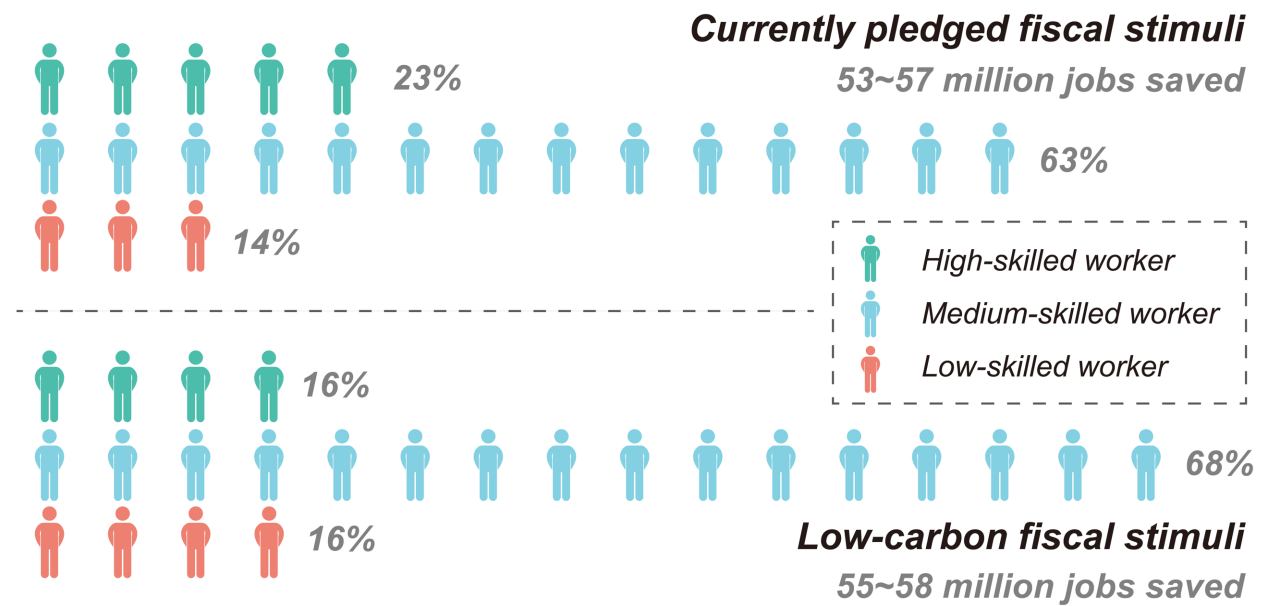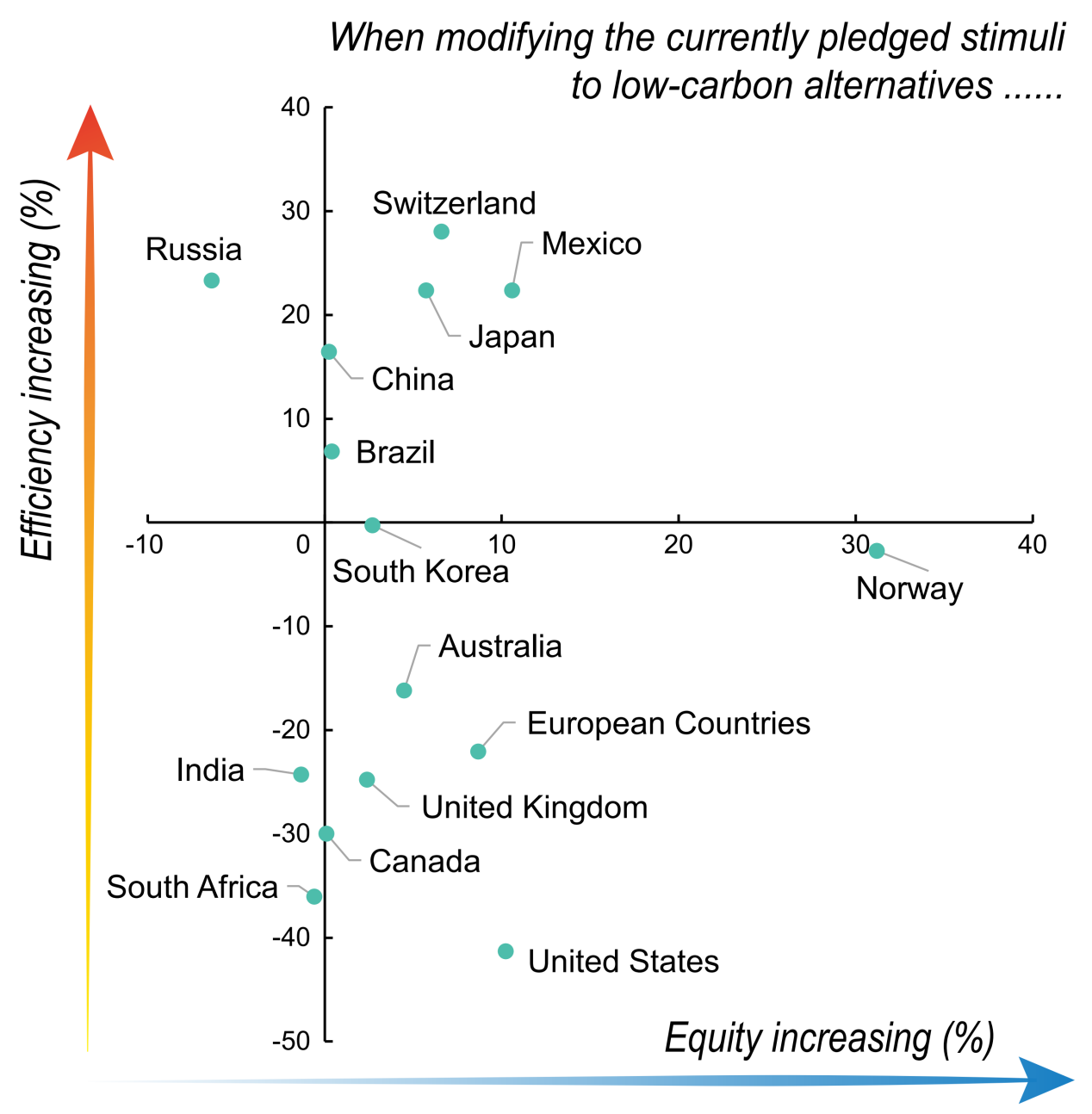The research group led by Professor Wang Can of the School of Environment, Tsinghua University assessed the economic and employment impacts of different post-pandemic fiscal stimulus in 26 countries, revealing the trade-off relations among low-carbon, efficiency and equity of stimulus and providing decision-making support for countries to develop greener and more inclusive economic stimulus in a coordinated response to economic recovery, equity improvement and climate change mitigation.
The tremendous social and economic impact of COVID-19 has become one of the most severe challenges in the history of mankind, intertwined with crises such as rising inequality and the risk of climate change. In response to the economic depression caused by the pandemic, some countries or regions have successively put forward stimulus and invested trillions of dollars in emergency economic aid, public health, education and research. The enormous size of stimulus also offers significant opportunities to improve social equity and combat climate change while revitalizing economy.
Against this backdrop, the research group, based on big data of travelling, management and control measures and other latest information since the outbreak of the pandemic, has built the extended adaptive regional input-output (E- ARIO) model, simulated the process in which the pandemic impacts the economy by affecting labor supply and the terminal demand, and the stimulus promotes economic recovery through direct investment or demand driving. By identifying differences in the distribution of employment and income impacts among skilled workers, the research group also assessed the effectiveness and equity of different stimulus in boosting economy and improving employment in 26 countries. Business as usual (BAU) scenario, non-stimulus scenario and three stimulus scenarios (Table 1) were set. Stimulus scenarios include currently pledged stimulus (CS), already announced by various countries, low-carbon stimulus (LS), designed to meet the goals of the Paris Agreement, and traditional stimulus (TS), the continuation of the past growth patterns.
Table 1 Scenario Settings

The results show that although the currently pledged economic stimulus can effectively reduce economic losses and increase employment compared with the non-stimulus scenario, it has the risk of exacerbating the income gap among different skill groups. Low-skilled workers, who have been hit harder by the pandemic, have relatively benefited less under the currently pledged stimulus (the increase in employment demand for low-skilled people is 38% to 41% less than that for high-skilled people) (Figure 1). Modifying the currently pledged stimulus to low-carbon alternatives could effectively boost the economy while reducing global income inequity by 2-3%. It is worth noting, however, that the overall synergy of low-carbon, efficiency and equity at the global level varies at the national level: 18 of 26 countries need to ensure low-carbon and equity of stimulus at the expense of economic efficiency (Figure 2).

Figure 1 The impact of economic stimulus on employment demand of people with different skills at the global level
The study pointed out that there is a potential risk that the stimulus currently committed by various countries will promote economic recovery at the expense of equity, which is more prominent in developed countries or regions such as the United States and the European Union. Low carbon stimulus in the short term, by contrast, can achieve the balance among low carbon green development, economic efficiency and social equity at the global level, but there are also differences at the national level: low carbon stimulus chosen by some countries to achieve more green and equal development may face, at the same time, the loss of economic efficiency. This means that there is no one-size-fits-all solution for green recovery, and countries need to carefully formulate more inclusive low-carbon stimulus according to their own national conditions.

Figure 2 Comparison of the efficiency and equity of economic stimulus and low-carbon stimulus committed by various countries at the national level
On April 25th, the research, titled The Perceived Effectiveness and Hidden Inequity of Post-Pandemic Fiscal Stimuli, was published online in the Proceedings of the National Academy of Sciences, an international academic journal. Zhang Yaxin, 2018 doctoral student, School of Environment, Tsinghua University, and Zheng Xinzhu, Associate Professor, School of Economics and Management, China University of Petroleum (Beijing) are the co-first authors of this paper. Wang Can, Professor of School of Environment, Tsinghua University, is the corresponding author of this paper. Professor Wang Can’s research group has long been devoted to the economics and policies of climate change, and energy, environment and economic system simulation, as well as cross-system impact assessment of climate change mitigation. This research is funded by the National Natural Science Foundation of China and the National Key R&D Program of China.
Link to the paper: https://www.pnas.org/doi/10.1073/pnas.2105006119





